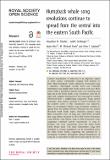Files in this item
Humpback whale song revolutions continue to spread from the central into the eastern South Pacific
Item metadata
| dc.contributor.author | Schulze, Josephine N. | |
| dc.contributor.author | Denkinger, Judith | |
| dc.contributor.author | Oña, Javier | |
| dc.contributor.author | Poole, Michael | |
| dc.contributor.author | Garland, Ellen Clare | |
| dc.date.accessioned | 2022-09-01T10:30:15Z | |
| dc.date.available | 2022-09-01T10:30:15Z | |
| dc.date.issued | 2022-08 | |
| dc.identifier | 280602971 | |
| dc.identifier | 0ca6ebcc-d89c-46fe-98ca-2c49e201fbbd | |
| dc.identifier | 000848127000010 | |
| dc.identifier | 85138580711 | |
| dc.identifier.citation | Schulze , J N , Denkinger , J , Oña , J , Poole , M & Garland , E C 2022 , ' Humpback whale song revolutions continue to spread from the central into the eastern South Pacific ' , Royal Society Open Science , vol. 9 , no. 8 , 220158 . https://doi.org/10.1098/rsos.220158 | en |
| dc.identifier.issn | 2054-5703 | |
| dc.identifier.other | ORCID: /0000-0002-8240-1267/work/118411928 | |
| dc.identifier.uri | https://hdl.handle.net/10023/25926 | |
| dc.description | Funding: COCIBA grants of USFQ National Geographic Society - W396-15; NERC Sea Mammal Research Unit - NE/R015007/1; Project CETACEA Ecuador Royal Society - NF140667, UF160081; Rufford Foundation. | en |
| dc.description.abstract | Cultural transmission of behaviour is an important aspect of many animal communities ranging from humans to birds. Male humpback whales (Megaptera novaeangliae) sing a repetitive, stereotyped, socially learnt and culturally transmitted song display that slowly evolves each year. Most males within a population sing the same, slow-evolving song type; but in the South Pacific, song ‘revolutions’ have led to rapid and complete replacement of one song type by another introduced from a neighbouring population. Songs spread eastwards, from eastern Australia to French Polynesia, but the easterly extent of this transmission was unknown. Here, we investigated whether song revolutions continue to spread from the central (French Polynesia) into the eastern (Ecuador) South Pacific region. Similarity analyses using three consecutive years of song data (2016–2018) revealed that song themes recorded in 2016–2018 French Polynesian song matched song themes sung in 2018 Ecuadorian song, suggesting continued easterly transmission of song to Ecuador, and vocal connectivity across the entire South Pacific Ocean basin. This study demonstrates songs first identified in western populations can be transmitted across the entire South Pacific, supporting the potential for a circumpolar Southern Hemisphere cultural transmission of song and a vocal culture rivalled in its extent only by our own. | |
| dc.format.extent | 15 | |
| dc.format.extent | 1077744 | |
| dc.language.iso | eng | |
| dc.relation.ispartof | Royal Society Open Science | en |
| dc.subject | Cultural evolution | en |
| dc.subject | Vocal learning | en |
| dc.subject | Humpback whale | en |
| dc.subject | Cultural transmission | en |
| dc.subject | South Pacific | en |
| dc.subject | Song | en |
| dc.subject | GC Oceanography | en |
| dc.subject | QH301 Biology | en |
| dc.subject | DAS | en |
| dc.subject.lcc | GC | en |
| dc.subject.lcc | QH301 | en |
| dc.title | Humpback whale song revolutions continue to spread from the central into the eastern South Pacific | en |
| dc.type | Journal article | en |
| dc.contributor.sponsor | NERC | en |
| dc.contributor.sponsor | The Royal Society | en |
| dc.contributor.sponsor | The Royal Society | en |
| dc.contributor.institution | University of St Andrews. Centre for Biological Diversity | en |
| dc.contributor.institution | University of St Andrews. Centre for Social Learning & Cognitive Evolution | en |
| dc.contributor.institution | University of St Andrews. Sea Mammal Research Unit | en |
| dc.contributor.institution | University of St Andrews. School of Biology | en |
| dc.identifier.doi | https://doi.org/10.1098/rsos.220158 | |
| dc.description.status | Peer reviewed | en |
| dc.identifier.grantnumber | NE/R015007/1 | en |
| dc.identifier.grantnumber | NF140667 | en |
| dc.identifier.grantnumber | UF160081 | en |
This item appears in the following Collection(s)
Items in the St Andrews Research Repository are protected by copyright, with all rights reserved, unless otherwise indicated.

